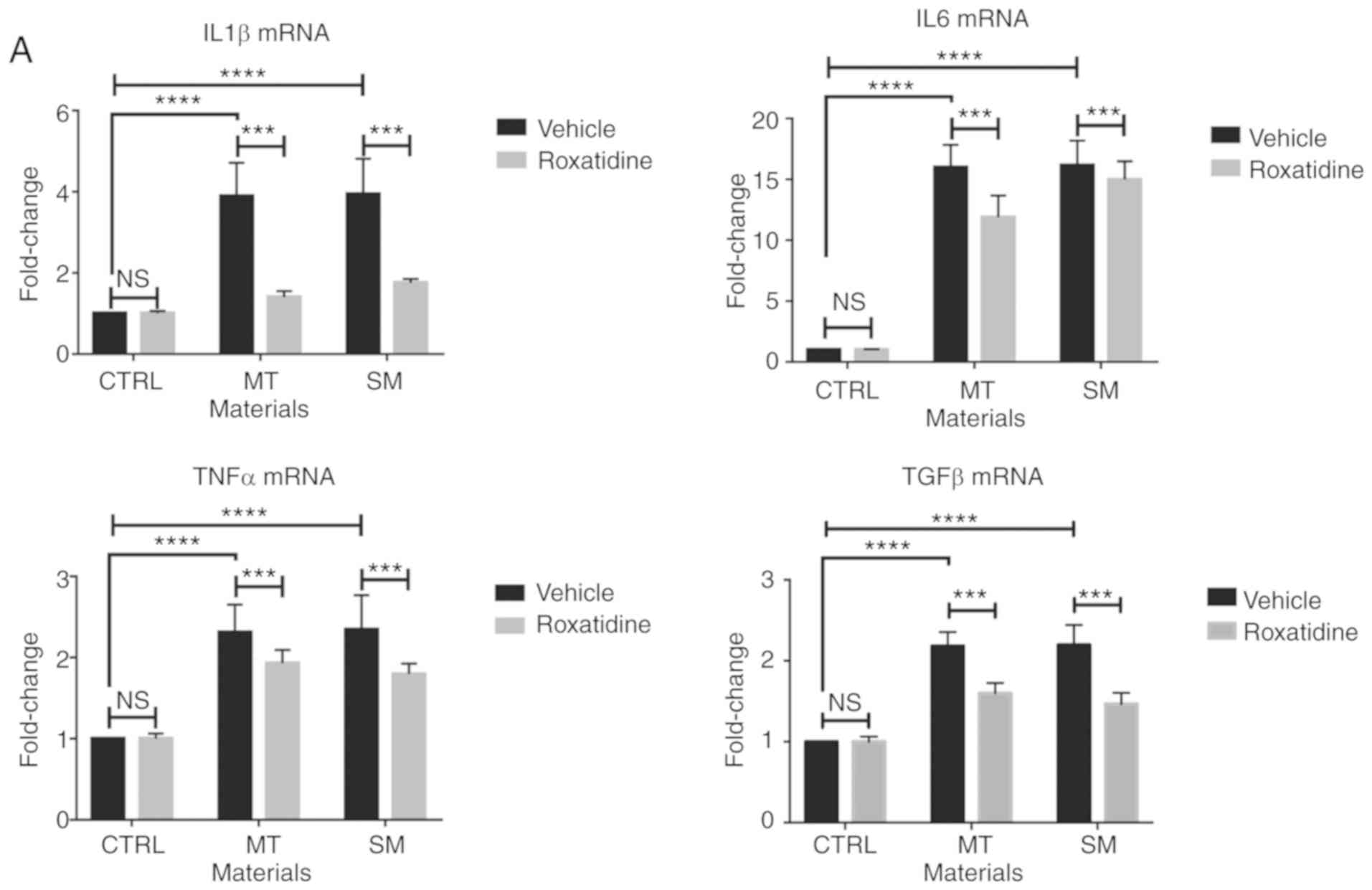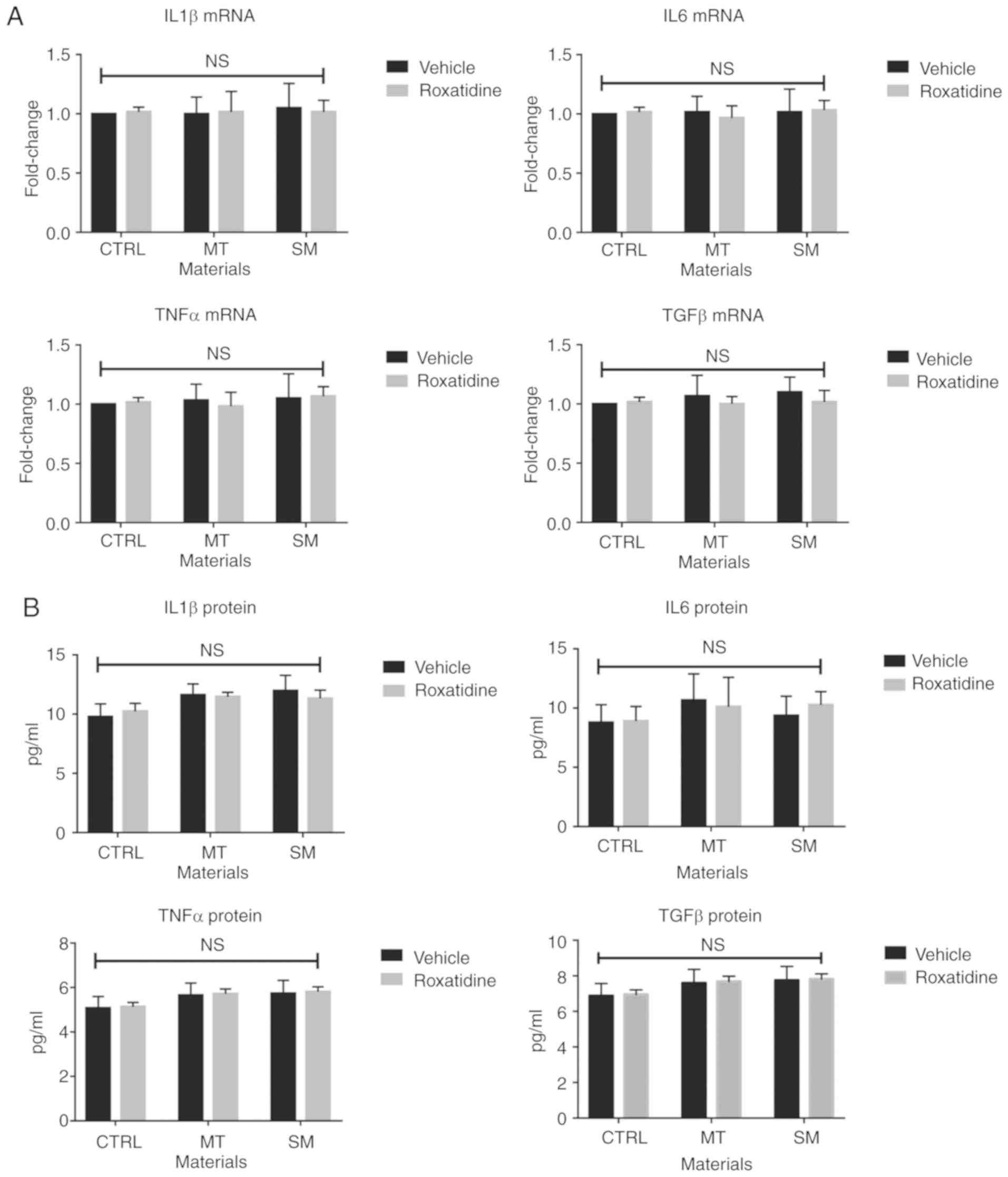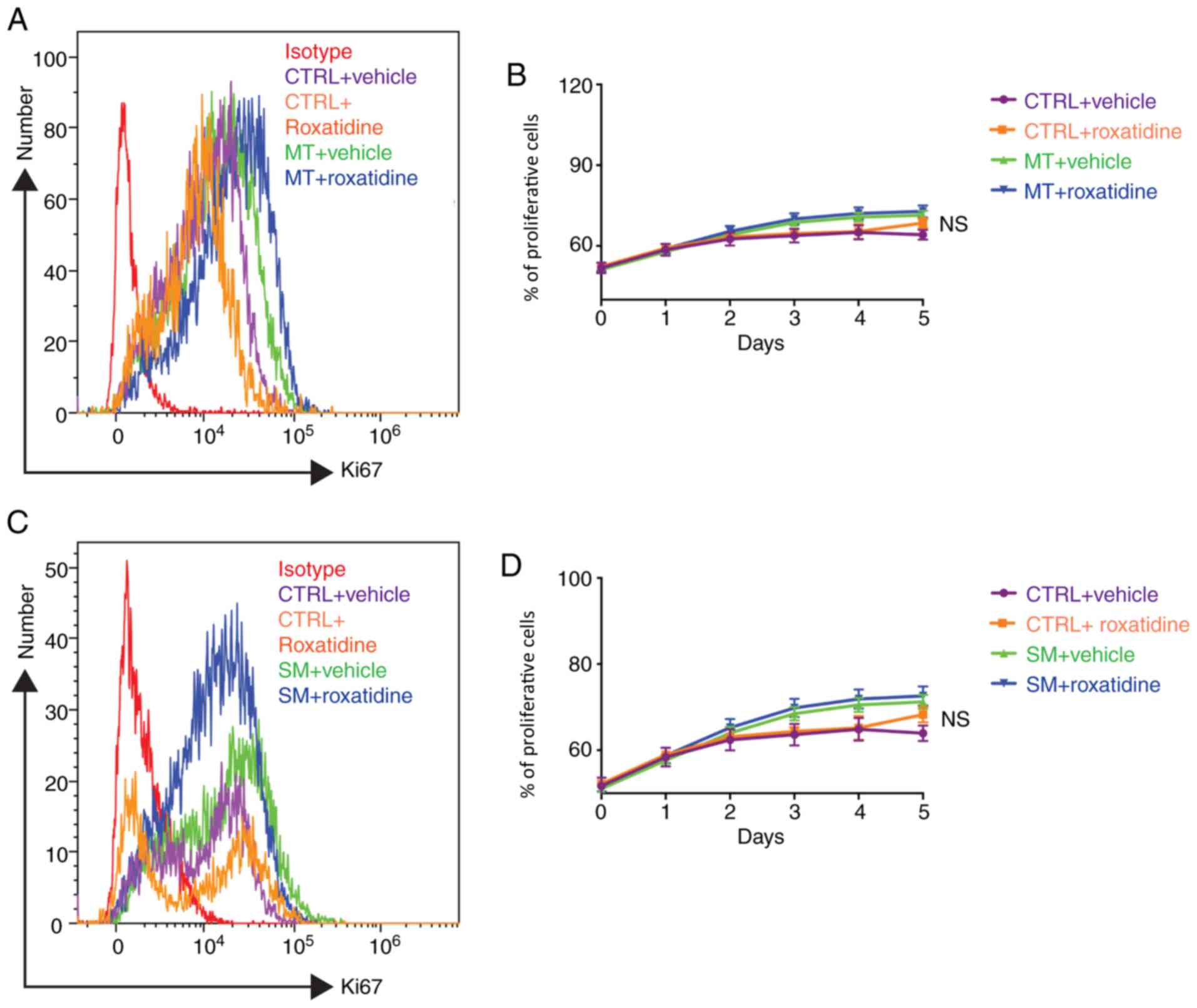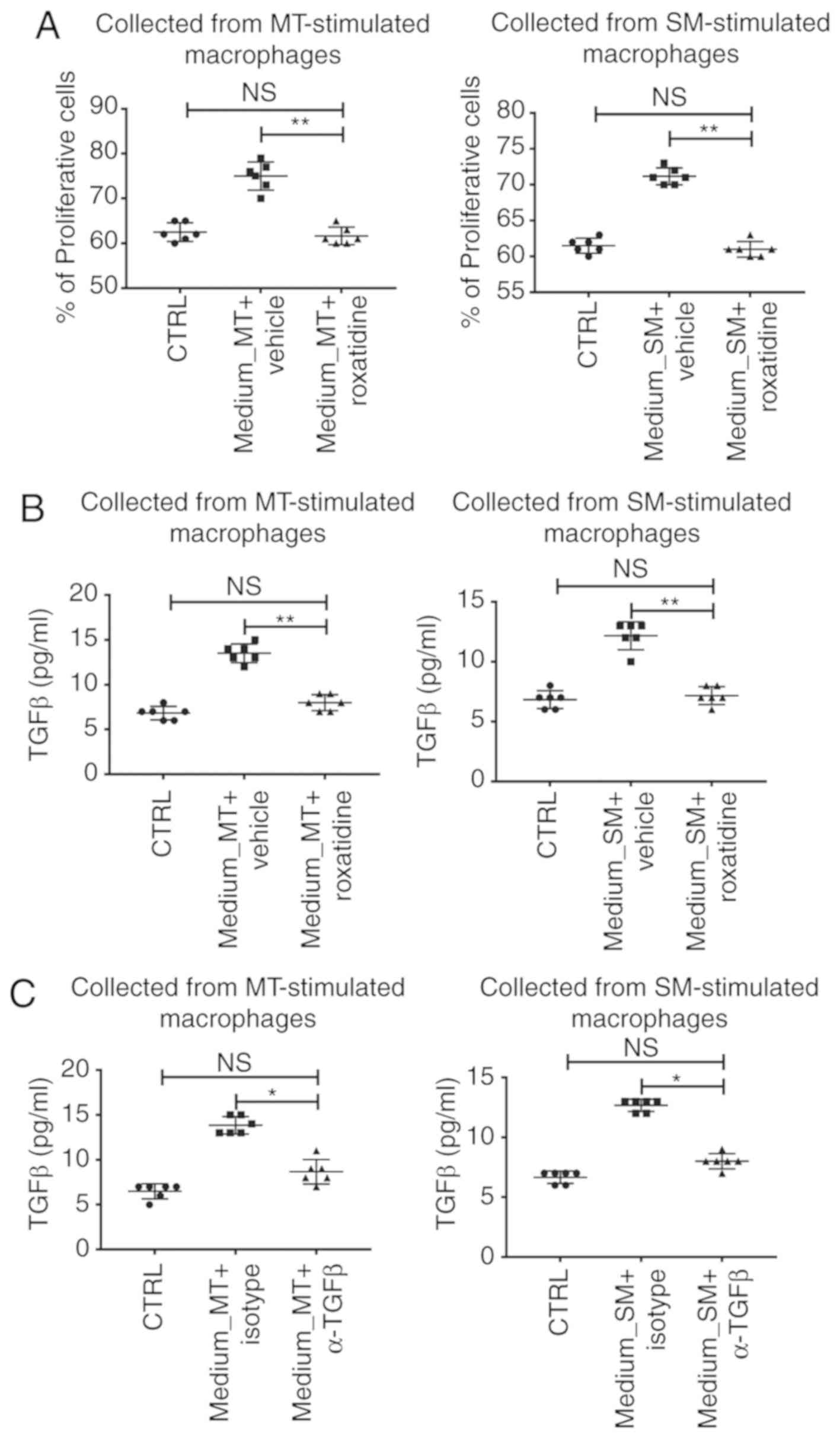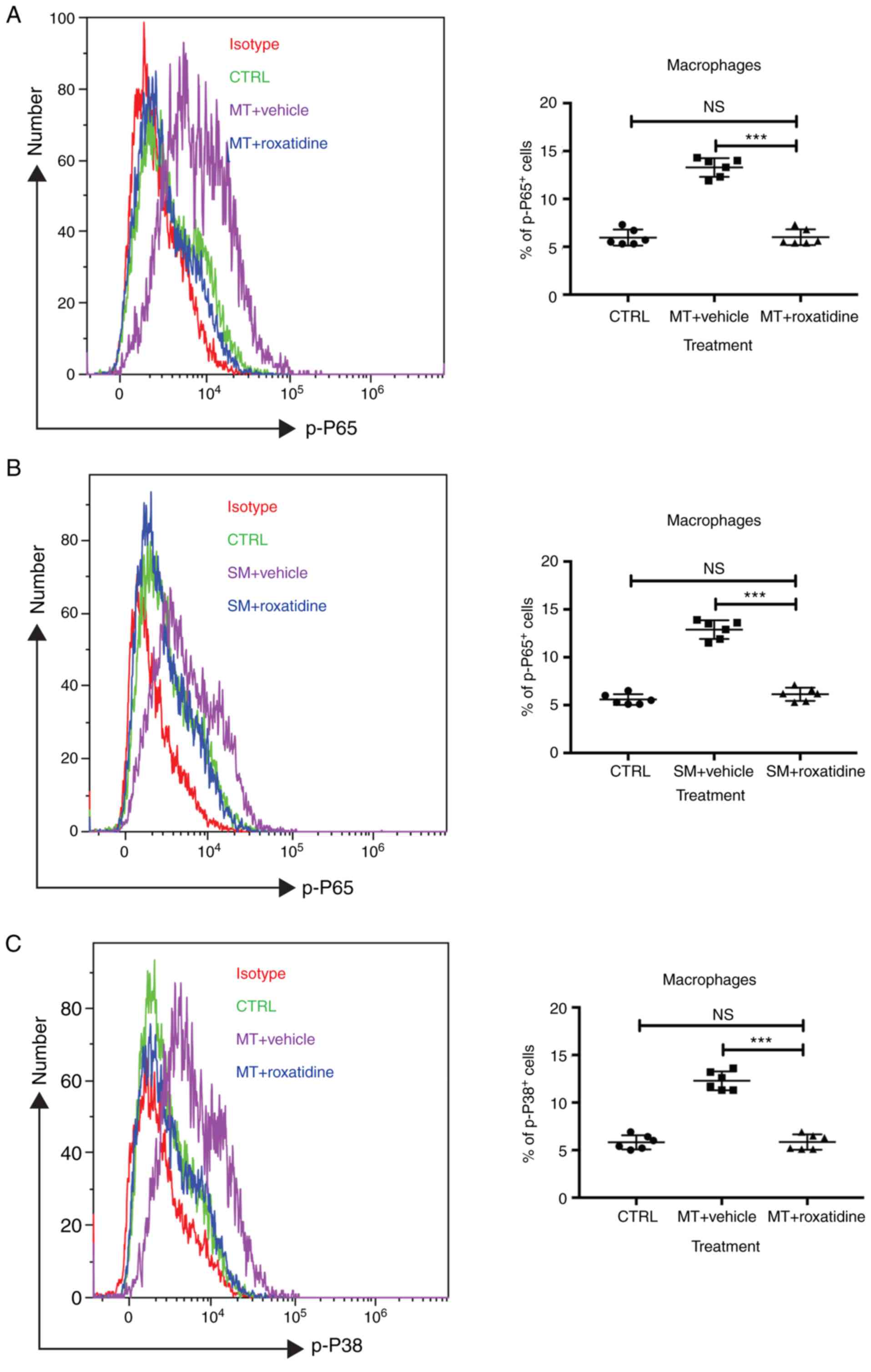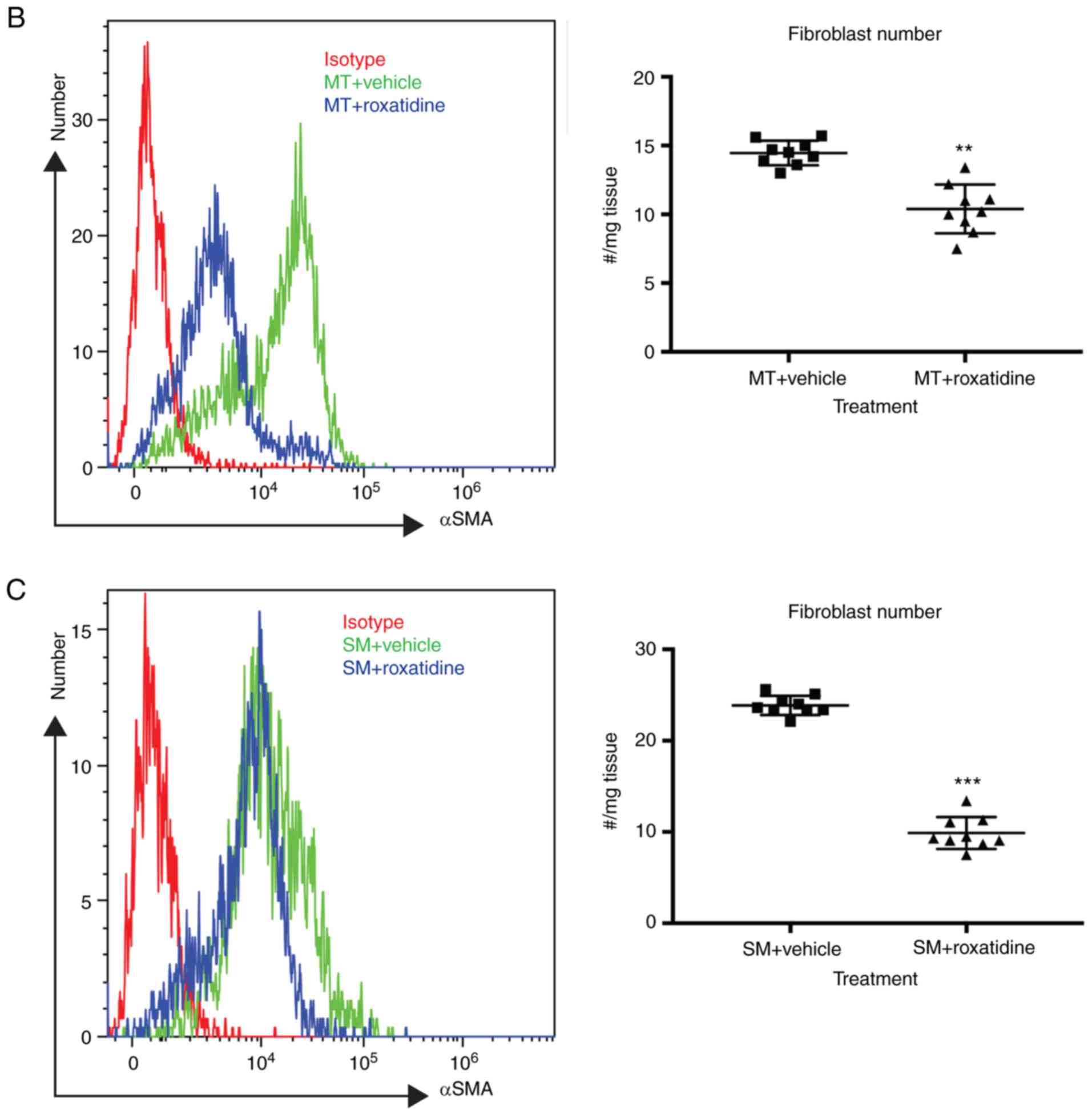Roxatidine inhibits fibrosis by inhibiting NF‑κB and MAPK signaling in macrophages sensing breast implant surface materials
- Authors:
- Published online on: November 12, 2019 https://doi.org/10.3892/mmr.2019.10815
- Pages: 161-172
-
Copyright: © Ji et al. This is an open access article distributed under the terms of Creative Commons Attribution License.
Abstract
Introduction
Silicone mammary implants (SMI) have been widely used for breast augmentation worldwide, making these materials the most commonly consumed in aesthetic surgery (1–3). It has been reported that approximately two million breast augmentation procedures are performed annually worldwide (4). Systemic and local complications after SMI breast augmentation surgery are often observed in patients, among which capsular contracture is the most common complication, with an incidence of >20% (5,6).
Capsular contracture is a serious complication and may resulted in distorted breast shape, pain and other symptoms (5,6). Based on clinical presentation, capsular contracture after breast augmentation is classified into 4 stages by the Baker grading system (7). Although a number of strategies have been proposed to prevent capsular contracture, such as different implant choices and improved surgical technique, the prevalence of this complication has not yet decreased (8). One strategy has been to preferentially choose textured materials over smooth breast implants (9,10). However, a fraction of patients would eventually undergo re-operation for capsular contraction, especially those with Baker-IV capsules, despite application of textured materials (9,10). As capsular contracture is a consequence of inflammation induced by the implanted silicone material surface (5,6), it is important to understand the mechanism of capsular contracture formation and the corresponding prophylaxis.
Fibroblasts and macrophages are major components in fibrotic capsules related to breast implants (10). Fibroblasts play a critical role in the pathogenesis of fibrotic capsules. For example, fibroblasts are enriched at the ‘contact zone’ of the implant and at the capsule responsible for initial capsule formation, by producing collagen fibres (11–14). The abundance of fibroblasts is positively associated with the severity of capsular contracture measured by the Baker grade (15). On the other hand, macrophages are key players in initiating tissue repair and remodelling (16). As it has been reported that macrophages enter the wound before fibroblasts do (17,18), it is possible that macrophages may have an influence on fibroblast functions. However, the crosstalk between macrophages and fibroblasts has not been explored.
Histamine was recognized to promote collagen formation more than four decades ago (19). Although it has been reported that blocking of histamine receptor (HR) 1 and 2 has inhibitory roles in collagen formation, these studies primarily focused on mast cells (15,20). Therefore, whether other cell types are involved in histamine-mediated collagen formation remains unknown. The aim of the present study was to assess the hypothesis that the HR2 inhibitor roxatidine can prevent capsular contracture after implantation. In this study, the effect of roxatidine on macrophages and fibroblasts during the pathogenesis of capsule formation was investigated.
Materials and methods
Ethics consideration
The ethics committee of the Fourth Affiliated Hospital of Harbin Medical University approved and supervised the research proposal (approval number, 170023).
Silicone surface particles
Spherical particles with a diameter of 6 mm were prepared from silicone implant envelopes under sterile conditions. The two most common materials in clinical practice were utilised, Mentor® Perthese™ micro-textured (MT) and smooth (SM) breast implants (21). Both implant materials were purchased from Johnson & Johnson, Inc.
Treatment
Roxatidine acetate (hydrochloride) was purchased from Sihuan Pharmaceutical Co., Ltd. For in vitro studies, roxatidine was dissolved in 0.05% DMSO (diluted in PBS). For in vivo studies, roxatidine was mixed with autoclaved tap water in a bolus of 100 µl.
Cell lines and culture
The murine macrophage cell line RAW 264.7 (ATCC) and the fibroblast cell line L929 (ATCC) were utilized in the present study. Both cell lines were cultured in α-Modified Eagle's Medium (α-MEM; Thermo Fisher Scientific, Inc.) supplemented with L-glutamine (Thermo Fisher Scientific, Inc.) and 10% fetal bovine serum (Thermo Fisher Scientific, Inc.) at 37°C with 5% CO2. For pre-treatment with roxatidine, roxatidine (25 µM) was added to the culture medium for 1 h at 37°C (22). For controls, vehicle (0.05% DMSO) was added to the control wells for 1 h at 37°C. Subsequently, RAW 264.7 macrophages (1×104) were co-cultured with different silicone surface particles for 24 h at 37°C, and then the conditioned media was collected for future L929 stimulation. Stimulated RAW 264.7 cells were then cultured in serum-free medium for another 24 h at 37°C, by the end of which the cells and media were used for reverse transcription-quantitative PCR (RT-qPCR) and ELISA analyses, respectively. Cells in the wells without addition of silicone implant surface materials served as controls. Cells were collected by straining culture media through a 100 µm cell strainer. Following centrifugation at 400 × g for 10 min at 4°C, cell-free culture media were used for ELISA analyses, whereas cells were lysed for RT-qPCR analyses. Following the 1 h culture in the presence or absence of roxatidine, L929 fibroblast cells (1×104) were co-cultured with different silicone surface particles or the macrophage-conditioned media for 24 h at 37°C. For culture of L929 cells using macrophage-conditioned media, at the end of the 24 h culture the media was replaced with serum-free media for another 24 h at 37°C, to perform ELISA and RT-qPCR analyses. For L929 proliferation analyses, implant materials were added to the wells, and fresh complete α-MEM was changed every 24 h at 37°C. To neutralize effects of TGFβ, TGFβ neutralizing antibodies (10 µg/ml, R&D Systems, Inc., cat. no. AB-100-NA) were applied to the culture medium when the breast implant materials were added or the conditional medium was used for L929 cells; whereas isotype control antibodies (Rabbit IgG, 10 µg/ml, R&D Systems, Inc., cat. no. AB-105-C) were used as control. Experiments (n=6 wells/group) were conducted in triplicate.
Reverse transcription-quantitative PCR (RT-qPCR)
Total RNA was extracted from RAW 264.7 and L929 cells using a commercial kit (RNeasy Mini kit; Qiagen GmbH) following the manufacturer's instructions. All RNA samples were stored at −80°C until analysis. Total RNA (2 µg) was reverse-transcribed to cDNA using an RT kit (High-Capacity cDNA Reverse Transcription kit, Thermo Fisher Scientific, Inc.), according to the manufacturer's manual. qPCR for target genes and the housekeeping gene GAPDH were performed using the SYBR® Green Master mix (Thermo Fisher Scientific, Inc.) following the manufacturer's instructions. Relative mRNA expression values were normalized according to levels of GAPDH. The fold change of mRNA expression was calculated using the formula: 2−ΔΔCq (23). The sequences of primers used are listed in Table I.
ELISA
ELISA was performed using R&D Systems DuoSet® kits equipped with corresponding mouse antibodies (R&D Systems, Inc., cat. nos.: IL1β, DY407; IL6, DY406; TNFα, DY470; and TGFβ, DY1679), according to the manufacturer's instructions. Briefly, a 96-well ELISA plate was incubated with the capture antibody (based on the target protein) overnight at room temperature. Following thorough washes using the Wash Buffer (R&D Systems, Inc., cat. no. WA126) the plate was blocked using 10% FBS at room temperature for 1 h. Cell culture media and standard samples were then added to the plate, followed by incubation at room temperature for 2 h. Biotinylated detection antibodies (provided with the DuoSet®kits) were then applied to the plate. Subsequently, the streptavidin-horseradish peroxidase solution was added and incubated for 20 min at room temperature, followed by the substrate solution for 20 min at room temperature. After adding the stop solution, the optical density of each well was detected by a microtiter plate reader at a wavelength of 450 nm.
Flow cytometry
At the end of culture, cells were collected from cell culture plates using 0.5 mM EDTA (Thermo Fisher Scientific, Inc.). Cells originating from tissue surrounding breast implant materials in mice were obtained using mechanical dissociation and enzymatic digestion, according to a previous paper (24). Cells were subsequently stained with antibodies listed in Table II for 30 min at 4°C, at the designated dilutions. To analyze proliferation, cells were stained with anti-Ki67 antibodies. To analyze signalling, RAW 264.7 macrophages were collected. Briefly, RAW 264.7 macrophages were cultured in serum-free media at 37°C for 24 h. Roxatidine (25 µM) was subsequently added to the media 1 h prior to stimulation with silicone surface materials. Macrophages were collected for analysis of phosphorylation of NF-κB subunit p65 and p38 MAPK by flow cytometry 15 minutes after adding silicone surface materials to culture media. The primary gate of cells was set for viable cells according to the plots of forward scatter side scatter. Corresponding isotype control antibodies were used for setting the negative population. Cells were analyzed using an Attune NxT flow cytometer (Thermo Fisher Scientific, Inc.) and Kaluza software (version 2.1; Beckman Coulter, Inc.).
Mouse breast implant studies
Prepared breast implant surface materials were seeded into 8-week old Balb/c female mice (weight ~20 g, Jackson Laboratory), according to a published paper (25). Mice were maintained in the specific-pathogen-free environment (control at constant 23°C and 40–60% humidity) with a 12-h light/dark cycle. Normal chow and water were allowed ad libitum. General anesthesia was administered by intraperitoneal injection of one dose of ketamine hydrochloride (100 mg/kg) and xylazine hydrochloride (10 mg/kg; Sihuan Pharmaceutical Co., Ltd.). Animals were maintained on a heated blanket at 37°C. Each mouse received one piece of implant material (up to 6 mm in diameter) in a subcutaneous pocket surgically created in the left flank and the incision was closed using 6-0 Vicryl sutures (Ethicon, Inc.). No animals died during the experimental period. Starting the day after surgery for 14 days, implant-bearing mice were treated daily by oral gavage with roxatidine (15.62 mg/kg) or PBS (control) (26). At day 90 post-surgery, mice were sacrificed under anesthesia and the fat tissue surrounding the implant material (5 mm distance from the implant surface) was collected for flow cytometry analysis of fibroblast abundance. Experiments (n=9 mice/group) were performed in duplicate.
Statistical analysis
Data are presented as the mean ± SD. Data were compared using the Student's t-test for two groups or one-way ANOVA followed by a Bonferroni post hoc test for more than two groups. Data with >2 groups at different time points were analyzed using two-way ANOVA with Tukey post hoc tests. P<0.05 was considered to indicate a statistically significant difference. Statistical analyses were performed using GraphPad Prism software (version 7; GraphPad Software, Inc.).
Results
Responses of macrophages cultured with silicone implant surface materials in the presence or absence of roxatidine
RAW 264.7 murine macrophages (1×104 cells/well) were maintained in 6-well plates containing each of the aforementioned materials for 24 h at 37 °C. Proinflammatory cytokines, interleukin (IL) 1β, IL6, tumor necrosis factor α (TNFα) and transforming growth factor β (TGFβ), have been reported to have critical roles in fibrosis generation after breast implant surgery (4,27). Therefore, the levels of these cytokines were assessed. As shown in Fig. 1A, culture of RAW 264.7 cells with different silicone implant surface materials increased mRNA levels of the proinflammatory cytokines assessed. Similar results were also observed at the protein level (Fig. 1B).
As it has been reported that administration of roxatidine inhibits macrophage activation upon stimulation (22), the subsequent investigation assessed whether roxatidine suppressed secretion of these proinflammatory cytokines by macrophages in a co-culture system with silicone implant surface materials. As shown in Fig. 1A and B, addition of roxatidine significantly reduced both the mRNA and protein levels of proinflammatory cytokines (P<0.01), indicating that roxatidine inhibited silicone implant material induced activation of macrophages.
Roxatidine has no effect on cytokine production or proliferation of cultured L929 cells in the presence of silicone surface materials
Subsequently, the effects of roxatidine on cultured L929 fibroblast cells in the presence or absence of silicone surface materials were investigated. As shown in Fig. 2A and B, addition of silicone surface materials did not affect the production of TGFβ at either the mRNA or protein level. Moreover, roxatidine treatment did not influence production of TGFβ by L929 fibroblast cells. Similarly, the levels of other proinflammatory cytokines did not change when L929 fibroblast were stimulated with or without the presence of roxatidine. The influence of roxatidine on L929 proliferation was then investigated, as excessive fibrosis caused by fibroblast proliferation is the main cause of implant failure (28). As shown in Fig. 3, silicone surface materials had no effect on L929 proliferation over time, measured by Ki67 expression, and neither did roxatidine.
Macrophage-conditioned media stimulated with silicone implant materials increases L929 cell proliferation and TGFβ production
The following investigation assessed whether conditioned media collected from macrophages co-cultured with silicone implant materials would have an effect on L929 functions in terms of proinflammatory cytokine production. As illustrated in Fig. 4A, although silicone implant materials had no effect on L929 proliferation, media collected from macrophages stimulated with MT or SM increased proliferation of L929, measured by flow cytometry. Moreover, production of TGFβ, a key player in fibrosis (28), was also increased in L929 cultured in MT or SM stimulated macrophage-conditioned media (Fig. 4B). However, when roxatidine was added to the culture media of macrophages in the presence of silicone implant materials, the levels of L929 proliferation and TGFβ production decreased to baseline (Fig. 4A and B). This result indicated that roxatidine-induced macrophage hypoactivation inhibited L929 proliferation and TGFβ secretion. Furthermore, when TGFβ neutralizing antibodies were added to the MT or SM stimulated macrophage-conditioned media for L929 culture, increased proliferation and TGFβ secretion were not observed (Fig. 4C). This indicated that the TGFβ-induced TGFβ production (a forward feedback loop) was essential for L929 proliferation.
Roxatidine inhibits macrophage activation by suppressing NF-κB and p38/MAPK signaling
It has been reported that roxatidine displays anti-inflammatory roles in other cell types by inhibiting activation of the NF-κB and p38/MAPK signaling pathways (22,29). Based on this, it was asked whether this would be the same case in macrophages stimulated with silicone implant materials. As shown in Fig. 5, administration of roxatidine to macrophages stimulated with silicone implanted materials inhibited activation of both signaling pathways. This suggested the possibility that inhibition of certain proinflammatory pathways might be the mechanism of roxatidine-mediated antifibrosis effects.
Administration of roxatidine in silicone implant bearing mice reduces fibrosis
Finally, the effects of roxatidine in silicone implant bearing mice were examined. Silicone implant surface materials were surgically seeded into the subcutaneous pocket of mice. At three months post-surgery, the surrounding tissue of the implants was removed and the amount of fibroblasts present was assessed by flow cytometry. As shown in Fig. 6A, administration of roxatidine reduced serum levels of TGFβ in both MT- and SM- bearing mice at day 90 post-surgery, suggesting that roxatidine decreased systemic TGFβ levels in mice with silicone implant materials. Furthermore, at three months post-surgery, there were fewer fibroblasts in the surrounding tissues of implant materials (Fig. 6B and C), indicating that roxatidine protected against fibrosis.
Discussion
The present study demonstrated that roxatidine inhibited proinflammatory cytokine production in macrophages stimulated with breast implant surface materials. Although roxatidine seemed to have no effect on fibroblast function, the inhibitory effect of roxatidine on macrophages indirectly resulted in reduced fibroblast proliferation, potentially via the TGFβ-dependent forward feedback loop. In vivo studies using implant-bearing mice also showed that roxatidine provided protection against fibroblast hyperplasia and TGFβ production.
Inflammation, especially early inflammation during post-surgery wound healing, plays an important role in fibrosis (30,31). It has been widely accepted that aberrant inflammation causes excessive fibrosis and subsequent capsular contracture in patients with breast implants (5,6). Based on this speculation, researchers have been seeking to control inflammation after breast augmentation procedures in order to prevent capsular contracture (12,32–34). Applications of anti-inflammatory strategies have been well reviewed elsewhere (35). Results from numerous experiments support the idea that limiting inflammation during the phase of wound healing inhibits fibrosis (12,32–34). In agreement with the aforementioned results (5,6), the present study also highlighted the important roles of inflammation in fibrosis as well as the crosstalk between macrophages and fibroblasts. Moreover, the present study showed that application of roxatidine inhibited excessive inflammation, as well as the NF-κB and MAPK signalling pathways.
The present study demonstrated the different roles of macrophages and fibroblasts during fibrosis. Here, it is proposed that these two cell types have varied functions in different phases. Macrophages, as sentinel cells, sensed the presence of foreign objects, including implant materials, via activation of the NF-κB and MAPK signaling pathways. Activated macrophages produced and released proinflammatory cytokines to the surrounding environment. On the other hand, fibroblasts failed to sense implant materials, but could be stimulated by the proinflammatory cytokines produced by activated macrophages, especially TGFβ. By acting with TGFβ and other proinflammatory cytokines, fibroblasts displayed increased levels of proliferation and TGFβ production, which could accelerate fibroblast proliferation and TGFβ secretion induced by TGFβ. Furthermore, roxatidine could block activation of macrophages by inhibiting NF-κB and MAPK signaling pathways to reduce proinflammatory cytokine production, fibroblast proliferation and fibrosis in vitro and in vivo.
The present study builds on the understanding of the cell types that roxatidine has effects on. It has been well documented that roxatidine influences mast cells during inflammation (22). However, the current study revealed that roxatidine could also affect macrophages by blocking macrophage activation by inhibiting NF-κB and MAPK signaling pathways. It was hypothesized that roxatidine blocks NF-κB and MAPK signaling pathways in both mast cells and macrophages, which are both essential cell types in inflammatory responses such as allergy and infection (36). Therefore, it is reasonable to speculate that inhibition of HR2 by roxatidine might have a wide anti-inflammatory role in a number of conditions including fibrosis and allergies, which could be explored in further investigations.
This study also provided more evidence for the applicability of pharmaceutical therapy for capsular contracture after breast implant surgery. Previous results from small scale trials indicate the potential benefit in softening and improving the appearance of the breast in patients treated with leukotriene receptor antagonists such as montelukast (37) or zafirlukast (38). Veras-Castillo et al (39) indicated that pirfenidone was superior to capsulectomy in patients, displaying a higher improvement rate and a lower relapse rate. It is worth noting that the aforementioned trials involved small cohorts, and further investigations are required.
The major pitfall of the present study is the lack of exploration into the roles of histamine on macrophages in fibrosis generation when breast implant materials are present. The data from the present study suggested that blocking HR2 by roxatidine had no effect on fibroblasts, but these results highlight important roles of HR2 on macrophages. However, how the HR2 is activated and what the cellular sources of histamine are remain untouched in the current study and in the literature. The present study presented two theories; however further exploration is required for clarification. The first theory is that macrophages sense foreign objects in the tissue and produce histamine. Secreted histamine acts on macrophages to enhance macrophage activation. The second is that other cells (for instance, basophils and mast cells) produce histamine to stimulate macrophages. Moreover, the protective effects of roxatidine when breast implant materials are seeded in the submuscular position were not assessed in the present study. It has been reported that the rate of capsular contracture is lower when breast implant material is surgically placed in the submuscular position compared to the subglandular plate (40–42). Therefore, it is reasonable to presume that the combination of roxatidine administration and insertion into the submuscular position should have a synergistic effect in preventing fibrosis generation. However, this combination requires further investigation.
In conclusion, the HR2 antagonist roxatidine blocked activation of macrophages by inhibiting the NF-κB and MAPK signaling pathways to prevent fibrosis and subsequent capsular contracture. These results raise the possibility that administration of roxatidine could aid in preventing capsular contracture in clinical practice.
Acknowledgements
Not applicable.
Funding
The present study was supported by the Department of Health of Heilongjiang Province to TW (grant no. 2010-118).
Availability of data and materials
The datasets used and/or analyzed during the present study are available from the corresponding author on reasonable request.
Authors' contributions
LJ performed most of the experiments including cell culture, flow cytometry, and animal surgery. TW performed data analysis and composed the first draft of the manuscript, as well as revisions. LT and HS performed statistical analysis and figure illustration. MG designed the present study and supervised the whole process. All authors have agreed the final version for publication.
Ethics approval and consent to participate
The ethics committee of the Fourth Affiliated Hospital of Harbin Medical University approved and supervised the research proposal (approval no.F 170023).
Patient consent for publication
Not applicable.
Competing interests
The authors declare that they have no competing interests.
References
|
Vegas MR and Martin del Yerro JL: Stiffness, compliance, resilience, and creep deformation: Understanding implant-soft tissue dynamics in the augmented breast: Fundamentals based on materials science. Aesthetic Plast Surg. 37:922–930. 2013. View Article : Google Scholar : PubMed/NCBI | |
|
Johnson M: Breast implants: History, safety, and imaging. Radiol Technol. 84:439M–520M. 2013.PubMed/NCBI | |
|
Cassileth L, Kohanzadeh S and Amersi F: One-stage immediate breast reconstruction with implants: A new option for immediate reconstruction. Ann Plast Surg. 69:134–138. 2012. View Article : Google Scholar : PubMed/NCBI | |
|
Cappellano G, Ploner C, Lobenwein S, Sopper S, Hoertnagl P, Mayerl C, Wick N, Pierer G, Wick G and Wolfram D: Immunophenotypic characterization of human T cells after in vitro exposure to different silicone breast implant surfaces. PLoS One. 13:e01921082018. View Article : Google Scholar : PubMed/NCBI | |
|
Headon H, Kasem A and Mokbel K: Capsular contracture after breast augmentation: An update for clinical practice. Arch Plast Surg. 42:532–543. 2015. View Article : Google Scholar : PubMed/NCBI | |
|
Namnoum JD, Largent J, Kaplan HM, Oefelein MG and Brown MH: Primary breast augmentation clinical trial outcomes stratified by surgical incision, anatomical placement and implant device type. J Plast Reconstr Aesthet Surg. 66:1165–1172. 2013. View Article : Google Scholar : PubMed/NCBI | |
|
Little G and Baker JL Jr: Results of closed compression capsulotomy for treatment of contracted breast implant capsules. Plast Reconstr Surg. 65:30–33. 1980. View Article : Google Scholar : PubMed/NCBI | |
|
Adams WP Jr: Capsular contracture: What is it? What causes it? How can it be prevented and managed? Clin Plast Surg. 36119–126. (vii)2009.PubMed/NCBI | |
|
Barnsley GP, Sigurdson LJ and Barnsley SE: Textured surface breast implants in the prevention of capsular contracture among breast augmentation patients: A meta-analysis of randomized controlled trials. Plast Reconstr Surg. 117:2182–2190. 2006. View Article : Google Scholar : PubMed/NCBI | |
|
Kuriyama E, Ochiai H, Inoue Y, Sakamoto Y, Yamamoto N, Utsumi T, Kishi K, Okumoto T and Matsuura A: Characterization of the capsule surrounding smooth and textured tissue expanders and correlation with contracture. Plast Reconstr Surg Glob Open. 5:e14032017. View Article : Google Scholar : PubMed/NCBI | |
|
Tan KT, Wijeratne D, Shih B, Baildam AD and Bayat A: Tumour necrosis factor-alpha expression is associated with increased severity of periprosthetic breast capsular contracture. Eur Surg Res. 45:327–332. 2010. View Article : Google Scholar : PubMed/NCBI | |
|
Prantl L, Angele P, Schreml S, Ulrich D, Poppl N and Eisenmann-Klein M: Determination of serum fibrosis indexes in patients with capsular contracture after augmentation with smooth silicone gel implants. Plast Reconstr Surg. 118:224–229. 2006. View Article : Google Scholar : PubMed/NCBI | |
|
Wolfram D, Rainer C, Niederegger H, Piza H and Wick G: Cellular and molecular composition of fibrous capsules formed around silicone breast implants with special focus on local immune reactions. J Autoimmun. 23:81–91. 2004. View Article : Google Scholar : PubMed/NCBI | |
|
Siggelkow W, Faridi A, Spiritus K, Klinge U, Rath W and Klosterhalfen B: Histological analysis of silicone breast implant capsules and correlation with capsular contracture. Biomaterials. 24:1101–1109. 2003. View Article : Google Scholar : PubMed/NCBI | |
|
Brazin J, Malliaris S, Groh B, Mehrara B, Hidalgo D, Otterburn D, Silver RB and Spector JA: Mast cells in the periprosthetic breast capsule. Aesthetic Plast Surg. 38:592–601. 2014. View Article : Google Scholar : PubMed/NCBI | |
|
Martinez FO, Sica A, Mantovani A and Locati M: Macrophage activation and polarization. Front Biosci. 13:453–461. 2008. View Article : Google Scholar : PubMed/NCBI | |
|
Brodbeck WG, Voskerician G, Ziats NP, Nakayama Y, Matsuda T and Anderson JM: In vivo leukocyte cytokine mRNA responses to biomaterials are dependent on surface chemistry. J Biomed Mater Res A. 64:320–329. 2003. View Article : Google Scholar : PubMed/NCBI | |
|
Brodbeck WG, Shive MS, Colton E, Nakayama Y, Matsuda T and Anderson JM: Influence of biomaterial surface chemistry on the apoptosis of adherent cells. J Biomed Mater Res. 55:661–668. 2001. View Article : Google Scholar : PubMed/NCBI | |
|
Cohen IK, Beaven MA, Horakova Z and Keiser HR: Histamine and collagen synthesis in keloid and hypertrophic scar. Surg Forum. 23:509–510. 1972.PubMed/NCBI | |
|
Zdolsek J, Eaton JW and Tang L: Histamine release and fibrinogen adsorption mediate acute inflammatory responses to biomaterial implants in humans. J Transl Med. 5:312007. View Article : Google Scholar : PubMed/NCBI | |
|
Sisti A, Tassinari J, Milonia L, Nisi G and Grimaldi L: Comparison of allergan, mentor, and sientra contoured cohesive gel breast implants: A single surgeon's 10-year experience. Plast Reconstr Surg. 138:548e–549e. 2016. View Article : Google Scholar : PubMed/NCBI | |
|
Lee M, Lee NY, Chung KS, Cheon SY, Lee KT and An HJ: Roxatidine attenuates mast cell-mediated allergic inflammation via inhibition of NF-κB and p38 MAPK activation. Sci Rep. 7:417212017. View Article : Google Scholar : PubMed/NCBI | |
|
Livak KJ and Schmittgen TD: Analysis of relative gene expression data using real-time quantitative PCR and the 2(-Delta Delta C(T)) method. Methods. 25:402–408. 2001. View Article : Google Scholar : PubMed/NCBI | |
|
Wang T, Wei Y, Tian L, Song H, Ma Y, Yao Q, Feng M, Wang Y, Gao M and Xue Y: C-C motif chemokine ligand 5 (CCL5) levels in gastric cancer patient sera predict occult peritoneal metastasis and a poorer prognosis. Int J Surg. 32:136–142. 2016. View Article : Google Scholar : PubMed/NCBI | |
|
Frenkiel BA, Temple-Smith P, de Kretser D and Southwick GJ: Follistatin and the Breast Implant Capsule. Plast Reconstr Surg Glob Open. 5:e12582017. View Article : Google Scholar : PubMed/NCBI | |
|
Liu J, Sun D, He J, Yang C, Hu T, Zhang L, Cao H, Tong AP, Song X, Xie Y, et al: Gastroprotective effects of several H2RAs on ibuprofen-induced gastric ulcer in rats. Life Sci. 149:65–71. 2016. View Article : Google Scholar : PubMed/NCBI | |
|
Joseph J, Variathu KT and Mohanty M: Mediatory role of interleukin-6 in alpha smooth muscle actin induction and myofibroblast formation around silicone tissue expander. J Biomed Mater Res A. 101:2967–2973. 2013. View Article : Google Scholar : PubMed/NCBI | |
|
Wynn TA and Ramalingam TR: Mechanisms of fibrosis: Therapeutic translation for fibrotic disease. Nat Med. 18:1028–1040. 2012. View Article : Google Scholar : PubMed/NCBI | |
|
Cho EJ, An HJ, Shin JS, Choi HE, Ko J, Cho YW, Kim HM, Choi JH and Lee KT: Roxatidine suppresses inflammatory responses via inhibition of NF-κB and p38 MAPK activation in LPS-induced RAW 264.7 macrophages. J Cell Biochem. 112:3648–3659. 2011. View Article : Google Scholar : PubMed/NCBI | |
|
Shaw TJ and Martin P: Wound repair at a glance. J Cell Sci. 122:3209–3213. 2009. View Article : Google Scholar : PubMed/NCBI | |
|
Gonzalez AC, Costa TF, Andrade ZA and Medrado AR: Wound healing-A literature review. An Bras Dermatol. 91:614–620. 2016. View Article : Google Scholar : PubMed/NCBI | |
|
Katzel EB, Koltz PF, Tierney R, Williams JP, Awad HA, O'Keefe RJ and Langstein HN: A novel animal model for studying silicone gel-related capsular contracture. Plast Reconstr Surg. 126:1483–1491. 2010. View Article : Google Scholar : PubMed/NCBI | |
|
Prantl L, Poppl N, Horvat N, Heine N and Eisenmann-Klein M: Serologic and histologic findings in patients with capsular contracture after breast augmentation with smooth silicone gel implants: Is serum hyaluronan a potential predictor? Aesthetic Plast Surg. 29:510–518. 2005. View Article : Google Scholar : PubMed/NCBI | |
|
Ulrich D, Lichtenegger F, Eblenkamp M, Repper D and Pallua N: Matrix metalloproteinases, tissue inhibitors of metalloproteinases, aminoterminal propeptide of procollagen type III, and hyaluronan in sera and tissue of patients with capsular contracture after augmentation with Trilucent breast implants. Plast Reconstr Surg. 114:229–236. 2004. View Article : Google Scholar : PubMed/NCBI | |
|
Araco A, Caruso R, Araco F, Overton J and Gravante G: Capsular contractures: A systematic review. Plast Reconstr Surg. 124:1808–1819. 2009. View Article : Google Scholar : PubMed/NCBI | |
|
Dobranowski P and Sly LM: SHIP negatively regulates type II immune responses in mast cells and macrophages. J Leukoc Biol. 2018.(Epub ahead of print). View Article : Google Scholar : PubMed/NCBI | |
|
Huang CK and Handel N: Effects of Singulair (montelukast) treatment for capsular contracture. Aesthet Surg J. 30:404–408. 2010. View Article : Google Scholar : PubMed/NCBI | |
|
Schlesinger SL, Ellenbogen R, Desvigne MN, Svehlak S and Heck R: Zafirlukast (Accolate): A new treatment for capsular contracture. Aesthet Surg J. 22:329–336. 2002. View Article : Google Scholar : PubMed/NCBI | |
|
Veras-Castillo ER, Cardenas-Camarena L, Lyra-Gonzalez I, Muñoz-Valle JF, Lucano-Landeros S, Guerrerosantos J, Gonzalez-Ulloa B, Mercado-Barajas JL, Sanchez-Parada MG, Azabache-Wennceslao R and Armendariz-Borunda J: Controlled clinical trial with pirfenidone in the treatment of breast capsular contracture: Association of TGF-β polymorphisms. Ann Plast Surg. 70:16–22. 2013. View Article : Google Scholar : PubMed/NCBI | |
|
Motosko CC, Khouri KS, Poudrier G, Sinno S and Hazen A: Evaluating platelet-rich therapy for facial aesthetics and alopecia: A critical review of the literature. Plast Reconstr Surg. 141:1115–1123. 2018. View Article : Google Scholar : PubMed/NCBI | |
|
Stevens WG, Harrington J, Alizadeh K, Berger L, Broadway D, Hester TR, Kress D, d'Incelli R, Kuhne J and Beckstrand M: Five-year follow-up data from the U.S. clinical trial for Sientra's U.S. Food and Drug Administration-approved Silimed(R) brand round and shaped implants with high-strength silicone gel. Plast Reconstr Surg. 130:973–981. 2012. View Article : Google Scholar : PubMed/NCBI | |
|
Hammond DC, Migliori MM, Caplin DA, Garcia ME and Phillips CA: Mentor Contour Profile Gel implants: Clinical outcomes at 6 years. Plast Reconstr Surg. 129:1381–1391. 2012. View Article : Google Scholar : PubMed/NCBI |



